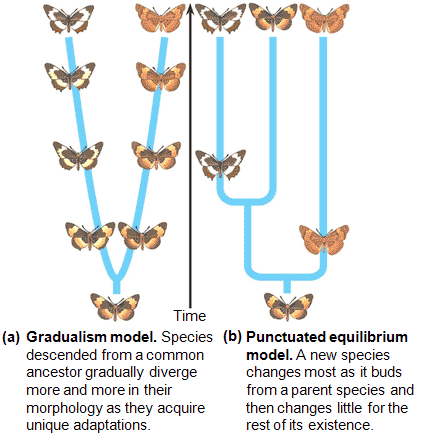| A | B |
|---|
| The evolutionary creation of new species is called ______. | speciation |
| Evolution above the species level (ie - the kind that creates new species) is called _______. | macroevolution |
| Evolutionary change that occurs within one species but doesn't immediately lead to speciation is called ______. | microevolution |
| The biological species concept defines a species as a population or group of populations whose members have the potential to _______ in nature and produce ______ but are unable to do the same with members of other populations. | interbreed, viable fertile offspring |
| _______ isolation is the existence of biological factors that impede members of two different species from producing viable fertile offspring. | Reproductive |
| ______ barriers cause biological isolation by impeding mating between species or by hindering the fertilization of ova if members of different species attempt to mate. | Prezygotic |
| Habitat isolation, temporal isolation, behavioral isolation, mechanical isolation, and gametic isolation are all examples of _______. | prezygotic barriers |
| ______ barriers cause biological isolation due to the inability of the hybrid zygote to develop into a viable fertile adult. | Postzygotic |
| Reduced hybrid viability, reduced hybrid fertility, and hybrid breakdown are examples of ______. | Postzygotic barriers |
| _______ speciation happens when a new species forms while geographically isolated from its parent population. | Allopatric |
| _______ speciation happens when a small population becomes a new species without geographic separation. | Sympatric ("patric" refers to homeland/country while "sym" means same. Sympatric speciation occurs in an organism's homeland while allopatric speciation occurs in a different homeland from the parent population) |
| Allopatric speciation occurs when gene flow is interrupted or reduced when a population is divided into two or more _______ isolated subpopulations. | geographically |
| _______ is the evolution of diversely adapted species from a common ancestor upon introduction to new environmental opportunities. | Adaptive radiation (Darwin's finches from the Galapagos are a classic example),  |
| The _______ model of evolutionary change describes evolution as happening in short fast spurts followed by long periods of little change. | Punctuated Equilibrium,  |
| The _______ model of evolutionary change describes evolution as happening slowly and steadily. | Gradualism,  |
| Evolutionary change often occurs due to adaptations to a _______. | changing environment |